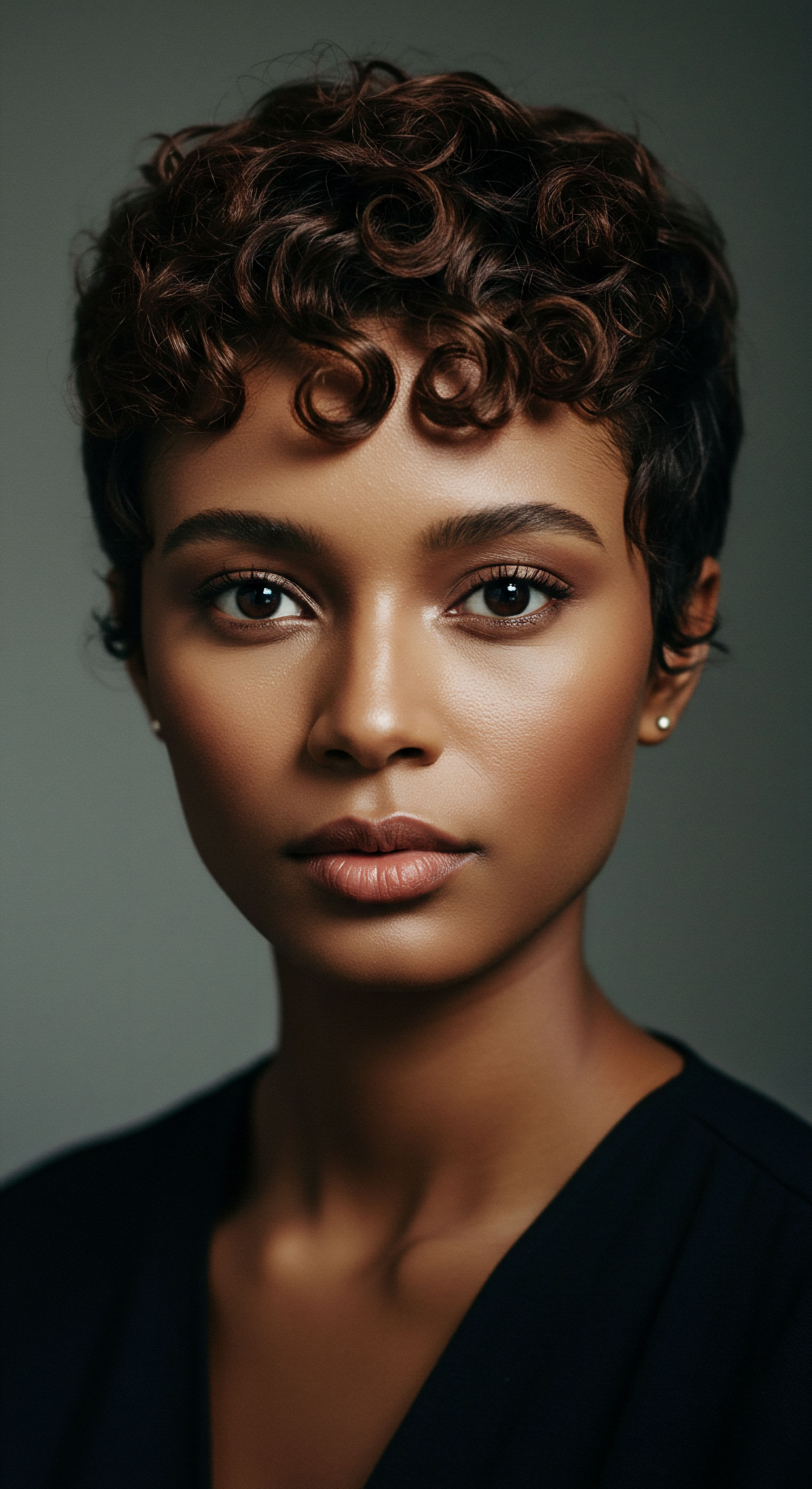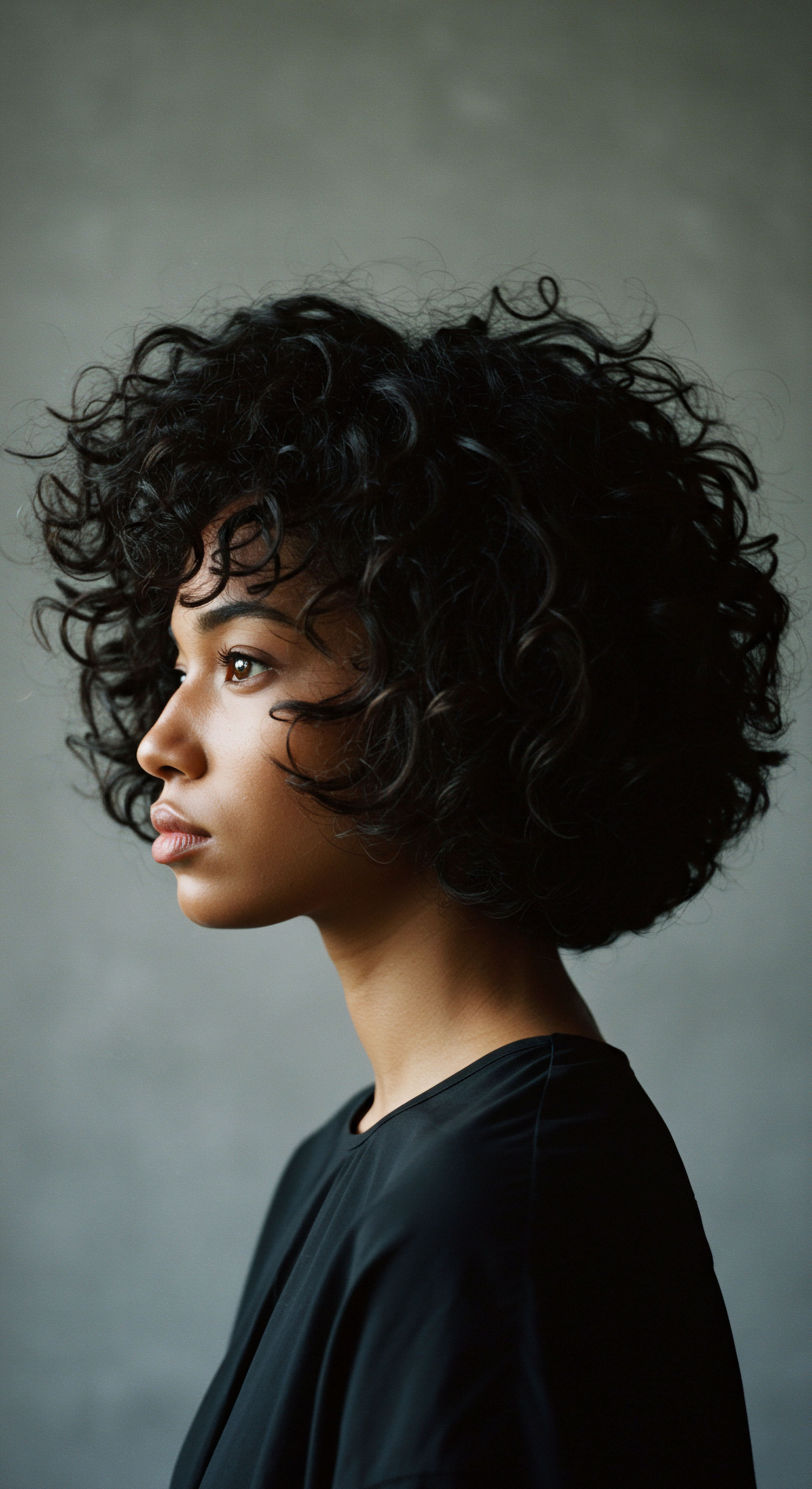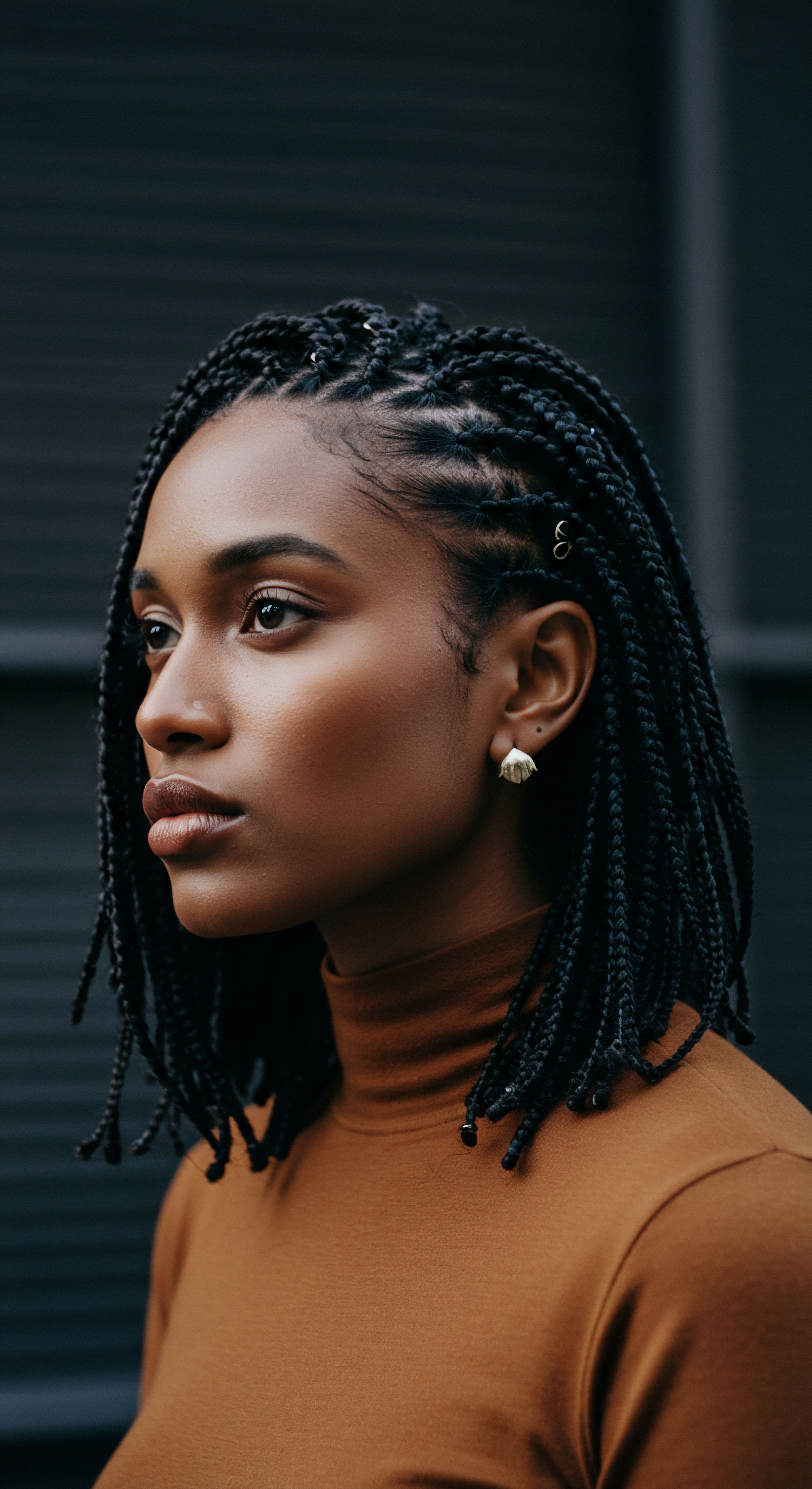
Roots
There is a quiet wonder in observing the simple strands that grow from our scalp, yet their silent presence once spoke volumes. Before the clamor of modern trends, hair carried deep societal messages, serving as a visual lexicon for entire communities. To truly grasp the significance of ancient hairstyles, one must consider how these adornments were not merely decorative, but rather served as profound declarations of self and standing. This exploration invites us to look beyond the surface, recognizing hair as a living record of human experience, identity, and collective belonging.

What Did Ancient Hair Tell Others About a Person?
Across various ancient civilizations, hair acted as a powerful identifier, instantly communicating details about an individual’s place within their world. From the Nile’s fertile banks to the bustling Roman forums, a person’s coiffure could reveal their gender, age, marital status, or even their social standing. In ancient Egypt, for example, the widespread use of wigs extended beyond mere aesthetics; they often symbolized social class and a commitment to hygiene. Archaeological finds, such as those from the Ramesside period, present wigs crafted with remarkable skill, sometimes adorned with precious metals and stones, reflecting the wearer’s elevated position.
Women of higher social standing often decorated their natural hair or wigs with flowers, ribbons, and elaborate headbands, a visual affirmation of their station. Conversely, Egyptian men frequently kept their hair short or shaved their heads completely, a practice particularly common among priests who maintained shaven heads for ritual purity, wearing wigs only for ceremonial occasions.
The young in ancient Egypt often wore a distinctive sidelock, known as the “Lock of Youth,” a small braid kept until puberty, after which they adopted styles characteristic of adults. This specific style marked a clear transition point in life, signaling the individual’s journey from childhood to maturity. In Greek and Roman societies, similar markers existed, though often with differing expressions. Greek maidens frequently displayed long, unbound hair, symbolizing youth and fertility, while married women might adopt more restrained styles.
The Romans, too, used hair as a visible signifier of wealth and power, especially among elite women. The more elaborate and artfully constructed the hairstyle, the more it suggested the wearer’s means, as such creations demanded hours of work from specialized hairdressers. A simple, natural style was often associated with those outside the established social order, perceived as lacking the resources or cultural refinement for complex arrangements.
Ancient hairstyles were not simply decorative choices; they were living languages, speaking volumes about a person’s place in their community.

Social Statements on the Head
The arrangements of hair in ancient African societies offered an even more granular system of communication. Here, hairstyles functioned as intricate maps, conveying information about an individual’s age, marital status, occupation, religious beliefs, or ethnic group. The meticulous process of hairstyling itself often formed a communal event, strengthening familial and social connections as techniques and meanings passed between generations.
Consider the significance of hair in the ancient Greek worldview. The Greeks regarded hair as a source of life and vitality. Its length and texture, from loose waves to tight curls, helped define Greek identity, often set against portrayals of non-Greeks.
For young men in Sparta, long hair was directly tied to qualities desired in a warrior, with Spartan fighters growing their hair long and carefully grooming it before battle. This physical presentation spoke volumes about their readiness and dedication.
| Civilization Ancient Egypt |
| Key Role of Hair Status, Hygiene, Age Marker |
| Examples Wigs for elite, shaved heads for priests, "Lock of Youth" |
| Civilization Ancient Greece |
| Key Role of Hair Identity, Vitality, Social Standing |
| Examples Long hair for maidens, specific styles for warriors, hair offerings |
| Civilization Ancient Rome |
| Key Role of Hair Wealth, Power, Social Distinction |
| Examples Elaborate updos for matrons, complex styles denoting status |
| Civilization Ancient African Societies |
| Key Role of Hair Social Map, Identity, Community |
| Examples Braids indicating age, marital status, occupation; communal styling |
| Civilization Hair across these cultures served as a potent non-verbal communication system. |

Ritual
Moving beyond the quiet statements of identity, we find that ancient hair practices often transcended daily appearance, stepping into the realm of the sacred and the ceremonial. Hair care and styling were frequently interwoven with life’s most profound transitions, becoming integral parts of rites and observances. These rituals, whether personal or communal, lent hair a deeper spiritual weight, transforming it into a conduit for connection, protection, and transformation. Let us now consider how these traditions shaped the very meaning of hair.

How Did Hair Serve in Ancient Rites of Passage?
Across the ancient world, hair played a central part in ceremonies marking significant life changes. These “rites of passage” often involved specific cutting or styling of hair. In ancient Greece, for instance, cultural milestones were closely tied to hair practices. Specific traditions existed for boys and girls as they moved through childhood, adolescence, and into adulthood.
Parents controlled the length and appearance of their children’s hair, and locks were often grown and then cut as dedications or thank offerings to deities, symbolizing major transitions. One striking custom from ancient Sparta involved brides shaving their heads as part of their wedding rituals, a symbolic act of submission. Athenian brides, in contrast, kept their hair, binding it for the wedding and adorning it with crowns and special veils.
The cutting of a young Egyptian’s sidelock was a true ritual, signifying that the child had officially crossed a threshold, moving beyond dangers that threatened the youngest members of society. This act was not a mere formality; it carried a protective and transformative meaning, marking a passage into a new stage of life. The meticulous attention given to hair in these moments underscored its importance as a physical manifestation of inner change and societal acceptance.
Hair was a key element in ancient rites, marking life’s shifts and spiritual moments.

Connecting to the Divine Through Hair
Beyond life stages, hair frequently held deep spiritual and magical connotations. Many ancient cultures believed hair possessed power, sometimes serving as a direct connection to the divine or as a protective charm. In ancient Egypt, hair was seen as a source of vitality and strength.
Offerings of hair, often in the form of braided locks, have been found in tombs dating back to the Predynastic Period, continuing even into Roman times, suggesting a persistent belief in hair’s magical and protective properties for the deceased. Even today, practices in some traditions involve hair in rituals for protection or influence, reflecting an ancient lineage of belief in hair’s inherent power.
For many Indigenous communities globally, hair is held as sacred, representing a connection to the earth, ancestors, and the spiritual realm. Long hair often symbolizes strength and wisdom, serving as a physical manifestation of thoughts and experiences. Specific hairstyles might be worn during ceremonies to honor spirits and natural forces.
Similarly, in Yoruba culture, certain communities would braid their hair to send messages to the gods, seeing the hair as the most elevated part of the body, thus connecting them with the divine. This spiritual link transformed hairstyling into an act of devotion and communication with higher powers.
- Offerings ❉ In ancient Greece, locks of hair were cut and dedicated to gods, particularly during rites of passage for young individuals.
- Protection ❉ Ancient Egyptians used hair, often in braided forms, as protective offerings in tombs, believing it safeguarded the deceased.
- Communication ❉ Some African communities styled hair in specific ways to communicate with deities or spiritual entities.

Relay
As we move deeper into the cultural currents of ancient hair, we discern its role extended far beyond personal expression or ritual observance. Hair became a potent instrument in the broader theater of societal power, a silent yet undeniable participant in dialogues of control, resistance, and collective identity. It was a visible declaration, sometimes mandated, sometimes defiantly chosen, always reflecting the intricate dynamics of human communities. To grasp this dimension, we must examine the interplay of social structures and individual agency as expressed through hair.

How Did Hairstyles Become Statements of Resistance?
Throughout history, hair has been a canvas for political statements and acts of defiance. Periods of social upheaval often saw shifts in hairstyles as individuals or groups sought to challenge existing norms or express solidarity. In ancient China, during the Qing dynasty, the “queue” hairstyle—involving a shaved front and a long braid—was mandated for Han Chinese men as a sign of submission to Manchu rule. This imposed style became a symbol of loyalty, yet its enforcement also sparked resentment and acts of resistance.
Perhaps one of the most compelling examples of hair as a tool of resistance comes from the experiences of enslaved Africans. During the transatlantic slave trade, slave traders often shaved the heads of captives, a brutal act designed to strip them of their cultural identity and humanity, rendering them anonymous chattel. Despite this systemic oppression, enslaved Africans found ways to reclaim their heritage and communicate. In a powerful demonstration of ingenuity and resilience, historical accounts indicate that some enslaved African women in South America utilized their cornrows to create intricate maps.
These hidden pathways, braided into their hair, detailed escape routes to freedom, a silent yet profound act of defiance against their captors. This practice underscores how deeply ingrained cultural knowledge, even under extreme duress, could be transformed into a literal guide for liberation. The meticulous care and planning required to execute such styles, while conveying complex information, speak volumes about the strength of cultural continuity in the face of dehumanization.
Hair, whether imposed or chosen, often served as a silent yet powerful voice in ancient societal dialogues.

Hair as a Tool of Social Control and Punishment
The converse of resistance was hair’s application as a means of social control and punishment. Its manipulation, or forced removal, could signify degradation or ostracization. Cutting someone’s hair without their consent, particularly for women, has a long history as a form of punishment directly related to political and cultural standing. This practice aimed to strip individuals of their public image and, by extension, their social capital.
In some historical contexts, the way hair was worn could distinguish between those considered “civilized” and “wild.” The Romans, as noted, associated natural, unstyled hair with barbarians, suggesting a lack of cultural refinement. This distinction served to reinforce social hierarchies and perceptions of superiority. The anthropologist Edmund Leach suggested in 1958 that while some viewed hair as a sexual metaphor, its cutting could symbolize social control. This perspective highlights how societies employed hair to define boundaries and enforce conformity.
| Aspect of Hair Mandated Styles |
| Role in Power Dynamics Symbol of Submission |
| Cultural Context Chinese queue during Qing Dynasty |
| Aspect of Hair Forced Removal |
| Role in Power Dynamics Dehumanization, Punishment |
| Cultural Context Shaving enslaved Africans' heads, public humiliation |
| Aspect of Hair Styling as Resistance |
| Role in Power Dynamics Covert Communication, Defiance |
| Cultural Context Cornrows as escape maps in South America |
| Aspect of Hair Elaborate Styling |
| Role in Power Dynamics Display of Wealth, Status |
| Cultural Context Roman matrons' complex coiffures |
| Aspect of Hair Hair acted as a constant, visible marker of societal authority or defiance. |

How Does Hair Connect to Collective Identity?
The collective identity of a group frequently found its expression in shared hair customs. This went beyond individual statements to solidify group cohesion and differentiate one community from another. For Orthodox Jews, for example, specific hairstyling and covering practices serve as a means of social control and group identity, denoting membership and marital status. The custom of married women covering their hair stems from the concept of modesty.
Similarly, the natural hair movement among Black American women, particularly gaining momentum in the 1960s, became a powerful symbol of collective identity and resistance against Eurocentric beauty standards. The Afro, in particular, became a symbol of Black pride, challenging societal norms and affirming African heritage. This collective choice in hair presentation served as a unifying force, signaling a shared experience and a renewed sense of cultural affirmation.
The biological reality of hair diversity among human populations, as explored by anthropologists, underscores the physical basis upon which these cultural meanings are built. While hair serves practical functions like insulation and protection, its variation in form and color across different groups has been historically interpreted and assigned social weight. This interplay between biology and culture means that hair is not simply a biological feature; it is a profound cultural construct, reflecting the very fabric of human society.

Reflection
Our exploration into the ancient world’s relationship with hair reveals a profound connection, one that speaks to the very core of human expression and communal life. From declarations of status etched into elaborate braids to silent acts of resistance woven into concealed pathways, hair stood as a powerful, living testament to who people were, what they believed, and how they navigated their worlds. These historical echoes remind us that hair remains a deeply personal and public statement, a constant dialogue between self and society, inviting us to consider the stories our own strands tell today.

References
- Harlow, Mary. A Cultural History of Hair in Antiquity. Bloomsbury Academic, 2021.
- Leitao, David. “Adolescent Hair-Growing and Hair-Cutting Rituals in Ancient Greece ❉ a Sociological Approach.” Initiation in Ancient Greek Rituals and Narratives ❉ New Critical Perspectives. Edited by David Dodd and Christopher A. Faraone, Routledge, 2003.
- Marshall, Amandine. “The magic and power of hair in ancient Egypt.” The Past, 20 February 2025.
- Byrd, Ayana, and Lori L. Tharps. Hair Story ❉ Untangling the Roots of Black Hair in America. St. Martin’s Press, 2001.
- Synnott, Anthony. “Shame and Glory ❉ A Sociology of Hair.” British Journal of Sociology, vol. 48, no. 3, 1987, pp. 381–413.
- Tarlo, Emma. Entanglement ❉ The Secret Lives of Hair. Oneworld Publications, 2016.
- Verma, Sonia. “Exploring Cultural significance of Hair.” Daily Excelsior, 2 February 2025.
- Leach, Edmund. “Magical Hair.” Journal of the Royal Anthropological Institute of Great Britain and Ireland, vol. 88, no. 2, 1958, pp. 147–164.
- Banks, Ingrid. Hair Matters ❉ Beauty, Power, and Black Women’s Consciousness. New York University Press, 2000.
- Jablonski, Nina G. “The Evolution of Human Skin and Skin Color.” Annual Review of Anthropology, vol. 33, 2004, pp. 585-623.